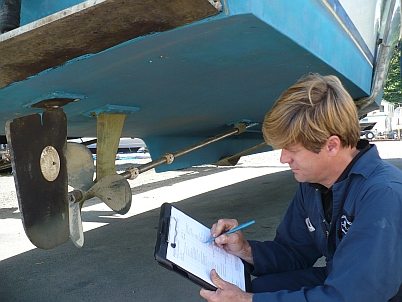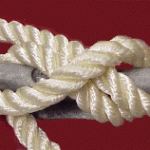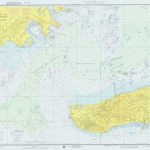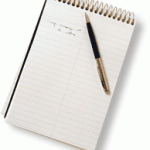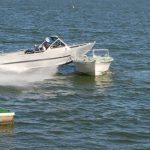BEFORE YOU LAUNCH:
Inspect and lubricate seacocks. Hoses and hose clamps should be inspected and replaced as necessary.
Replace deteriorated zincs.
Inspect prop(s) for dings, pitting and distortion. Make sure cotter pins are secure. Grip the prop and try moving the shaft – if it’s loose, the cutlass bearing may need to be replaced.
Check to make sure the rudderstock hasn’t been bent.
Inspect the hull for blisters, distortions and stress cracks.
Make sure your engine intake sea strainer is free of corrosion and properly secured.
Check the engine shaft and rudder stuffing boxes for looseness. After the boat is launched, be sure to check these as well as through-hulls for leaks.
Use a hose to check for deck leaks at ports and hatches. Renew caulk or gaskets as necessary. OUTDRIVES and OUTBOARD ENGINES:
Inspect rubber outdrive bellows for cracked, dried and/or deteriorated spots (look especially in the folds), and replace if suspect.
Check power steering and power trim oil levels. Replace worn-out zincs.
Inspect outer jacket of control cables. Cracks or swelling indicate corrosion and mean that the cable has to be replaced.
ENGINES AND FUEL SYSTEMS:
Inspect fuel lines, including fill and vent hoses, for softness, brittleness or cracking. Check all joints for leaks and make sure all lines are well supported with non-combustible clips or straps with smooth edges.
Inspect fuel tanks, fuel pumps and filters for leaks. Clamps should be snug and free of rust. Clean fuel filters.
Inspect cooling hoses and fittings for stiffness, rot, leaks and/or cracking. Make sure they fit snugly and are double-clamped.
Every few years, remove and inspect exhaust manifold for corrosion.
Clean and tighten electrical connections, especially both ends of battery cables. Wire-brush battery terminals and fill cells with distilled water.
Inspect bilge blower hose for leaks.
SAILBOAT RIGGING:
Inspect fittings for cracks and rust. Inspect wire halyards and running backstays for “fishhooks” and rust.
Remove tape on turnbuckles and lubricate threads, preferably with Teflon. Replace old tape with fresh tape.
Recaulk through-deck chainplates as necessary (generally, once a decade).
TRAILERS:
Inspect tire treads and sidewalls for cracks or lack of tread and replace as necessary. Check air pressure. Don’t forget the spare!
Inspect bearings and repack as necessary.
Test tail and back-up lights. Test winch to make sure it’s working properly.
Inspect trailer frame for rust. Sand and paint to prevent further deterioration.
MISCELLANEOUS:
Check expiration dates on flares and fire extinguishers.
Check stove and remote tanks for loose fittings and leaking hoses.
Inspect bilge pump and float switch to make sure it’s working properly.
Inspect dock and anchor lines for chafing.
Update or replace old charts, waterway guides.
Check shore power cable connections for burns, which indicates the cable needs to be replaced.
Make sure your boating license and/or registration is up to date. Don’t forget your trailer tags.
Review your boat insurance policy and update coverage if needed. Be sure you have fuel spill insurance coverage.
Make sure you have a properly sized and wearable life jackets in good condition for each passenger, including kids and pets.

